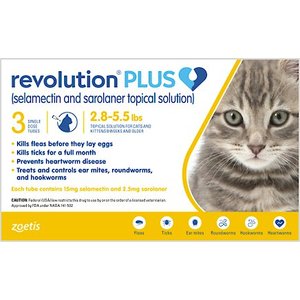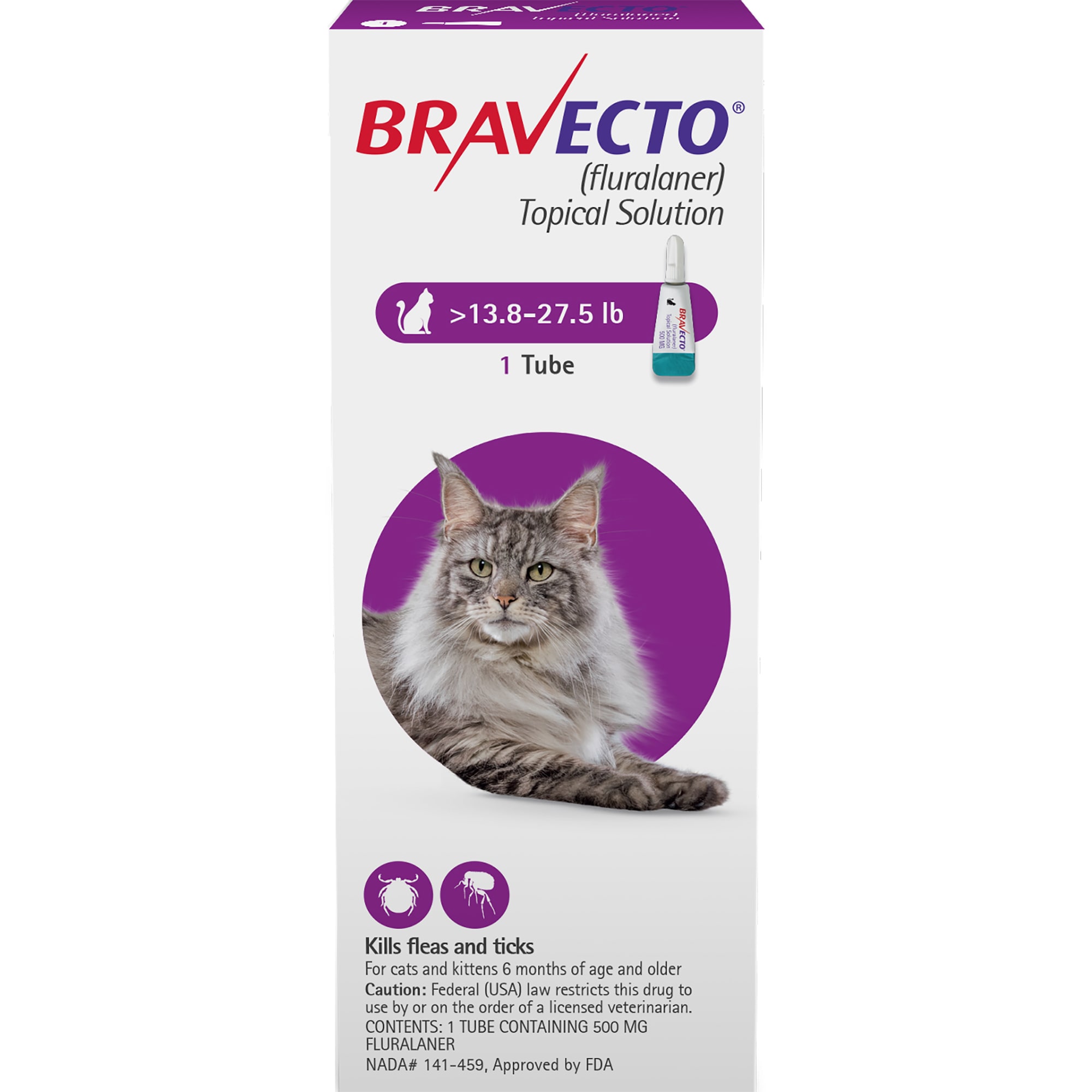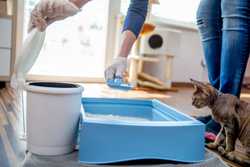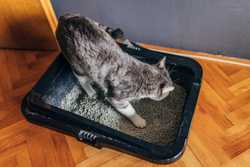How to Get Rid of Fleas On Cats: It’s Time to Bite Back

Our evaluations and opinions are not influenced by our advertising relationships, but we may earn a commission from our partners’ links. This content is created by TIME Stamped, under TIME’s direction and produced in accordance with TIME’s editorial guidelines and overseen by TIME’s editorial staff. Learn more about it.
Despite the presence of over 300 species of fleas in the United States alone, only one in particular has a preference for cats: Ctenocephalides felis, also known as the cat flea. Despite the moniker, these fleas are happy to get to know your dog and humans, too. Dogs have a flea named in their honor, as well: Ctenocephalides canis, or the dog flea. However, the cat flea is usually the one that affects domestic dogs, at least in North America.
More importantly, how do you know if your cat has fleas and what do you do about them? Read on to learn more about these bloodthirsty little creatures.
Not all cats will have extreme itchiness from fleas, but if a cat has developed an allergy to proteins in flea saliva, even just one flea feeding on them can cause intense scratching, licking, and/or biting at their skin. You might see redness, scabs, and/or fur loss (from excessive grooming and scratching), particularly along the back. Other super itchy areas are the back of the neck, the hind legs, base of the tail, and the belly—especially between the hind legs.
Flea dirt is a more pleasant way of saying flea poop. Often, you’ll see these small, black specks on a cat’s skin instead of the fleas themselves. If you suspect your cat has fleas, part their fur and look for flea dirt.
You might also find flea dirt elsewhere, such as on your cat’s bed—and yours if your cat sleeps with you. If you’re unsure that what you’ve found is flea dirt, put some on a paper towel and add water. If it turns red, it’s flea dirt.
Fleas are fast, so when you part your cat’s fur and start searching for them, you may or may not see them. This is true for the environment too—and there, you may only see 5 to 10% of them. To have greater success finding fleas on your pet, use a flea comb, whose teeth are set closer together than regular combs.
A flea comb will pick up fleas, flea dirt, and eggs (though you aren’t likely to see eggs because they’re so small—about 0.5 mm). However, if your pet has longer fur, brush out any tangles first. Otherwise, pulling a fine tooth flea comb through tangles is something akin to your mom hurriedly brushing your tangled heap of hair when you were a kid.
Cats can get fleas from other animals—wild or domestic—including stray cats, your dog, or other people’s pets they encounter. They can also pick up fleas from the environment where any flea-infested pets or other wildlife have been.
Fleas can also come into your home on their own through windows or doors. If you moved into an apartment or home, fleas could potentially already be there, such as in the carpet or yard. In fact, the vibration of walking on carpet, or vacuuming carpet, will cause flea eggs to hatch. Even bringing in flea-infested used furniture or carpet can introduce fleas to your home.
Some flea preventatives are prescription and some are not. If you’re unable to take your pet to the veterinarian, you can still call them for a recommendation on what to get over-the-counter.


You can’t treat your pet and not the environment—both are required to resolve the problem. Treat your cat(s) and dog(s) at the same time you treat the environment; if not the same day, then at least within one day of each other.
Wash everything you can with hot water in the washing machine: cat bed, your sheets, clothes, pillows, plush pet toys, etc. Do this weekly until the flea infestation is resolved. And yes, this may be quite a while—a few months even.
While things are in the washer, vacuum everything. Carpet, couches, curtains, chairs, mattresses—anything that has fabric. Fleas love fabric. If you have a steam cleaner, that’s great to use too on carpet and upholstery. In the ideal world, vacuuming should be done daily until the flea infestation is resolved. If this just isn’t possible, then try for every two to three days, with weekly being the bare minimum.
Whether you have a bagless vacuum or one with a bag, you need to empty it out every single time you vacuum. Otherwise, the fleas will just find their way out of the trash, including eggs that hatched because of the vacuum’s vibration. For bagless vacuums, empty the contents in the trash, close the trash and take it outside, and then clean the vacuum parts with hot soapy water.
For vacuums with a bag, place the bag in the trash, close the trash, and take the bag outside.
Consult a professional pest control service about treating your home (and yard if you have one) every three to four weeks with pet-friendly products. Another option is using food-grade diatomaceous earth (DE) but keep in mind that it’s not very effective after it gets wet. It’s also less effective in humid environments. If using DE indoors, apply it to surfaces like carpet once a week and let it sit for 24 to 48 hours before vacuuming it up. If this just isn’t practical for your situation, then let it sit for four hours. Four hours won’t kill all the fleas in the carpet but it will kill some.
Keep in mind that inhaling DE can be irritating for pets and people, so don’t use it if you or your pets have respiratory issues such as asthma. Even if you and your pets don’t have lung issues, wear a mask while treating areas and have your pets out of the area being treated.
If your cat is clearly uncomfortable—scratching a lot, excessive licking, and/or biting at their skin—take them to a veterinarian. You should also schedule an appointment if you see any of the following: fleas, flea dirt, fur loss, irritated/red skin, sores, scabs, tapeworm segments around the anus (more on this later), or any other abnormal appearance to your cat’s skin or fur. Fleas are not easy to get rid of, so it’s ideal to get veterinary help. If you have pet insurance or you signed up for a pet wellness plan at your veterinary clinic, check to see if flea products are covered.
If your cat is a kitten, they absolutely should see a veterinarian because compared to an adult cat, they’re more prone to becoming anemic from fleas. And, some products are unsafe to use on kittens until they reach a certain age.
In order to get rid of fleas indoors, all cats and dogs must be treated with an appropriate flea product and you’ll need to treat your indoor environment (and outdoor, if applicable)—all within 24 hours of each other. It’s a lot of work, but it’s necessary to ensure success. In addition to the detailed cleaning recommendations outlined earlier, if you have a one cat/no dog home and you can keep your cat indoor 100% of the time, do so.
It’s also important that pets stay on year round flea prevention because fleas aren’t just summer creatures. They’re out in the cold, as well. Fleas can survive for 10 to 20 days when temperatures are between 33 and 46 degrees Fahrenheit. Even if there’s a long freeze, fleas aren’t just outside. Like you, they can be inside too, where it’s nice and warm. Your indoor environment (and even the warmer dens and burrows of wildlife) can be a great place for fleas to have a cozy winter on the couch by the fireplace. Also, since it can take months of diligent laundering and vacuuming to rid a home of fleas, keeping pets on prevention through the winter is a small price to pay in comparison.
The flea is a wingless insect where males are about 2 to 3 mm long and females are about 4 mm long. The cat flea affects cats, dogs, birds, and over 130 wild mammal species across all continents except Antarctica. Despite the title of my article (which I couldn’t resist), fleas don’t actually bite. It’s more of a slice-and-slurp. They pierce the skin with serrated blade-like mouthparts, then insert a straw-like part and slurp away. With the energy demands of egg laying, female fleas ingest more blood than males.
There are a variety of feline problems that can arise from fleas, some of which are mild and some are severe.
Follow your veterinarian’s directions for flea treatments for your cats and dogs—the frequency of treatment depends on the product. Keep your cats and dogs on a preventative year round because fleas from the summer can winter indoors.
Get into the habit of washing bedding and vacuuming once a week. If you have a yard that your pets go into, keep the lawn short. If needed, use diatomaceous earth or have a professional spray your home and yard every three to four weeks with a pet-friendly product.
The information presented here is created by TIME Stamped and overseen by TIME editorial staff. To learn more, see our About Us page.



